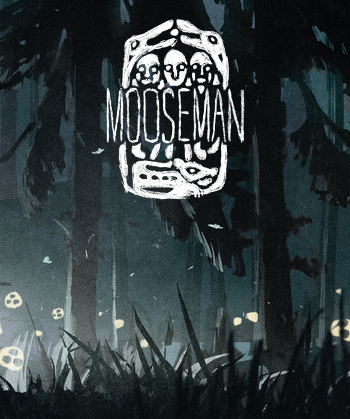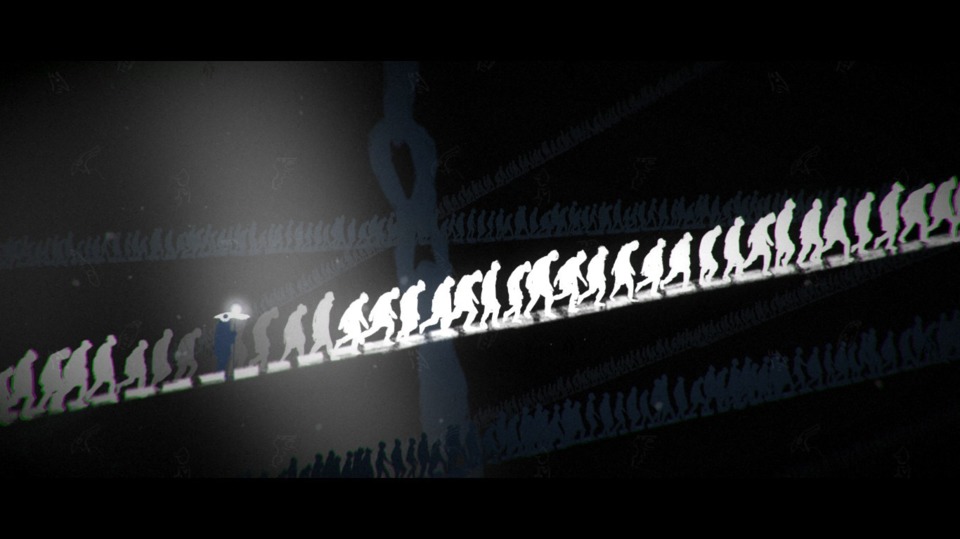
I don't know if we have a concept page for this, but The Mooseman is another in a series of what I tend to call Anthropology Adventure games: those that exist in part to educate the world about the customs and folklore of the developers' distant ancestors. Other examples of this include Year Walk, which invoked an ancient Swedish legend, and Never Alone, which did the same for a traditional Iñupiaq (Native Alaskan) story. The Mooseman is loosely based on the legends of the Slavic peoples of the Perm Krai region of modern Russia of around a millennium ago, and concerns the fate of the titular mooseman: a demigod who has the task (shared with his six brothers, who all draw lots beforehand to figure out whose turn it is) of taking a piece of the sun ("shondi") from its home in the Lower World (as in, the land of the dead) all the way up to the Upper World (the land of the gods) so that its light may shine on all of creation for another day.
This journey, which has the protagonist wander across all three worlds evading guardian deities and other hazards along the way, is depicted wholly in a 2D manner where the common objective is to go left to right by any means possible. Much of the game is spent simply walking through picturesque scenery, frequently marvelling at the landscape and creatures in the background, though the game has its fair share of puzzles also. Many of these puzzles revolve around the mooseman's divine-inherited power of insight, which allows them to see the spirits and gods that are otherwise invisible to mortal eyes. A basic puzzle using this power might involve a spectral bridge that only appears while the power is active, and another might involve beckoning a spirit creature - whose "mortal" form is an inconspicuous rock - towards the player character so that its rock form can be used to walk up to a high ledge or hold down a switch. The game is never particularly action-heavy - the mooseman has a fixed movement speed and there's no way to attack anything, besides a brief interlude where you play as a hunter instead - and is closer to the cadence of a 2D horror adventure game like Limbo or Detention. Though, that said, it's not particularly scary unless you really have a thing against enormous spiders or giant pikes (those sequences were pretty chilling, I'll admit).

The Mooseman is definitely more about the journey than the destination, especially given the inference that one of the seven moosemen must take this walk every day. Though it stays graphically simple, using silhouettes and a monochromatic color scheme for the most part, it's never short on spectacle. Sights like watching hundreds of Ort (spirits of the deceased) take the long Final Walk to the underworld or witnessing the birth of a new day as the mooseman gets close to his destination are often stunning, and the game takes steps to ensure that the source material is depicted as realistically and faithfully as possible. Traditional folk music and various lore notes about the creatures the player encounters also help establish the rules of this otherwise surreal environment, and a game-wide scavenger hunt for well-hidden collectible artifacts - which are shaped like genuine items of artwork left behind by this thousand-year-old civilization - ensures that there's plenty left to discover on subsequent playthroughs. I think you have to be in a very specific mood for a game like this, which might be a little on the slow and dull side without the added historical context, but I found it fascinating and arresting and I hope this trend continues to encourage developers from all over the world to plunder their own mythology in order to produce striking video games.
(Oh hey, shout out to fellow GB blogger @mooseymcman. It's kinda impossible to see this game's title without thinking of you.)
Rating: 4 out of 5.
| < Back to 121: Dandara | The First 100 | > Forward to 123: Figment |

Log in to comment